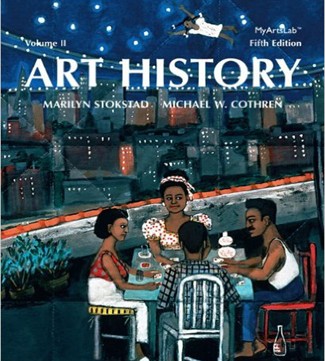Art History 5th Edition Volume 2 Stokstad Cothren Test Bank
$35.00 Original price was: $35.00.$26.50Current price is: $26.50.
Art History 5th Edition Volume 2 Stokstad Cothren Test Bank
This is completed downloadable of Art History 5th Edition Volume 2 Stokstad Cothren Test Bank

Product Details:
- ISBN-10 : 0205938442
- ISBN-13 : 978-0205938445
- Author: Marilyn Stokstad, Michael W. Cothren
Art History 5th edition continues to balance formal analysis with contextual art history in order to engage a diverse student audience. Authors Marilyn Stokstad and Michael Cothren- both scholars as well as teachers- share a common vision that survey courses should be filled with as much enjoyment as learning, and that they should foster an enthusiastic, as well as an educated, public for the visual arts.
This revision is the strongest and most comprehensive learning program for measuring student progress and improving student success in attaining the outcomes and goals of the art history survey course. Not only does the text address four overarching goals of the survey course, the new MyArtsLab further develops and reinforces these outcomes and skills with market-leading learning tools such as personalized study plans for each student and multimedia assets geared towards addressing different learning styles and abilities, such as chapter audio, student videos, Closer Looks, architectural panoramas and much more. The end result is a complete learning program designed to increase students’ success with a personalized, digital and a highly mobile learning experience.
Table of Content:
Multiple Choice
1. Chauvet Cave is located in __________.
A. Ireland
B. northern Spain
C. southeastern France
D. coastal France
Answer: C
Page reference: 9
2. Homo sapiens appeared on the earth __________ years ago.
A. 300,000
B. 400,000
C. 100,000
D. 50,000
Answer: B
Page reference: 2
3. The word “Neolithic” means __________.
A. new stone
B. symbolic writing
C. writing in stone
D. new history
Answer: A
Page reference: 2
4. Archaeologists link the emergence of image making to the arrival of __________.
A. Homo sapiens
B. Paleo sapiens
C. Homo sapiens sapiens
D. Neo sapiens
Answer: C
Page reference: 2
5. Representational images began appearing in Australia, Africa, and Europe beginning
approximately __________ years ago.
A. 100,000
B. 40,000
C. 25,000
D. 10,000
Answer: B
Page reference: 2
6. _________ evidence shows that modern humans moved from Africa, across Asia,
into Europe, and finally to Australia and the Americas between 100,000 and 35,000
years ago.
A. Geological
B. Architectural
C. Archeological
D. Written
Answer: C
Page reference: 2
7. Relative to art, one of man’s important new cognitive developments was the ability to
_________.
A. use tools
B. think symbolically
C. write
D. communicate verbally
Answer: B
Page reference: 3-4
8. Prehistoric people often coated their floors with powdered __________.
A. ash
B. bones
C. clay
D. ocher
Answer: D
Page reference: 5
9. As long ago as __________ BCE, figurines of people and animals appeared.
A. 50,000
B. 30,000
C. 25,000
D. 10,000
Answer: B
Page reference: 5
10. The Lion-Human sculpture from Hohlenstein-Stadel, Germany is made of
__________.
A. cast clay
B. molded bronze
C. mammoth ivory
D. porcelain clay
Answer: C
Page reference: 5
11. The Woman from Brassempouy captures the essence of a head, also called the
__________ __________.
A. memory image
B. abstracted mind
C. soul image
D. mind image
Answer: A
Page reference: 7
12. The earliest known prehistoric cave painting site was discovered in 1994 and is
called __________.
A. Altamira
B. Chauvet
C. Pech-Merle
D. Lascaux
Answer: B
Page reference: 9
13. Small-scale female sculptures from the Upper Paleolithic period were once called
__________figures, which implied a religious association, although this has not yet
been proven.
A. tomb
B. Venus
C. Eve
D. servant
Answer: B
Page reference: 6
14. Prehistoric cave paintings were first discovered in Spain in the________________.
A. 20th century
B. 19th century
C. Middle Ages
D. Roman Empire
Answer: B
Page reference: 8
15. Most Neolithic architecture in Germany and central Europe consisted of wood posts
supporting a central beam or __________.
A. supporting rail
B. ridgepole
C. major post
D. common beam
Answer: B
Page reference: 16
16. Walls of woven branches that were covered with mud or clay, or ______ and______
was a common building technique used in central Europe during the Neolithic period.
A. mottle; pole
B. hard; fast
C. head; daub.
D. wattle; daub.
Answer: D
Page reference: 16
17. Rows of trapezoidal buildings made of wooden posts, branches, mud, and clay
characterize the architectural remains at_____________.
A. Lepenski Vir
B. Çatalhöyük
C. Skara Brae
D. Sesklo
Answer: A
Page reference: 13
18. The simplest form of construction used to span space is __________-and-
__________.
A. post; lintel
B. post; beam
C. brace; cannon
D. lintel; strut
Answer: A
Page reference: 19
19. Continually rebuilt and replastered, early houses at Çatalhöyük may have functioned
as ____________.
A. observatories
B. temples
C. production centers for tools and pottery
D. historical markers
Answer: D
Page reference: 13-14
20. The word megalithic means __________.
A. middle stone
B. new rock
C. old stone
D. large stone
Answer: D
Page reference: 16
21. Stonehenge was created in __________ phases of construction and activity,
starting in 3000 BCE during the Neolithic Period and stretching over a millennium and a
half into the Bronze Age.
A. eight
B. two
C. ten
D. four
Answer: A
Page reference: 17
22. Scholars see the transport of bluestones to Stonehenge from more than 150 miles
away as a sign of ________________.
A. the lack of local stone
B. evidence of engineering technology
C. connections to an ancestral homeland
D. ritual significance of materials
Answer: C
Page reference: 18
23. Stonehenge was built in __________-and-__________ construction.
A. post; lintel
B. corbel; cantilever
C. lintel; beam
D. post; corbel
Answer: A
Page reference: 18
24. The lintels of Stonehenge are secured by __________-and-__________ joints.
A. post; lintel
B. anchor; beam
C. mortise; tenon
D. link; stem
Answer: C
Page reference: 18
25. In approximately __________ BCE, prehistoric humans began firing clay in the form
of vessels.
A. 15,000
B. 12,000
C. 7000
D. 2500
Answer: B
Page reference: 21
26. The age of metal made its European debut around __________ BCE.
People Also Search:
art history 5th edition volume 2
art history 5th edition volume 2 stokstad cothren
art history 5th edition volume 2 stokstad cothren test bank download pdf
art history 5th edition volume 2 stokstad cothren download scribd
Related products
Test Bank
Test Bank for Clinical Immunology and Serology A Laboratory Perspective, 3rd Edition: Stevens











